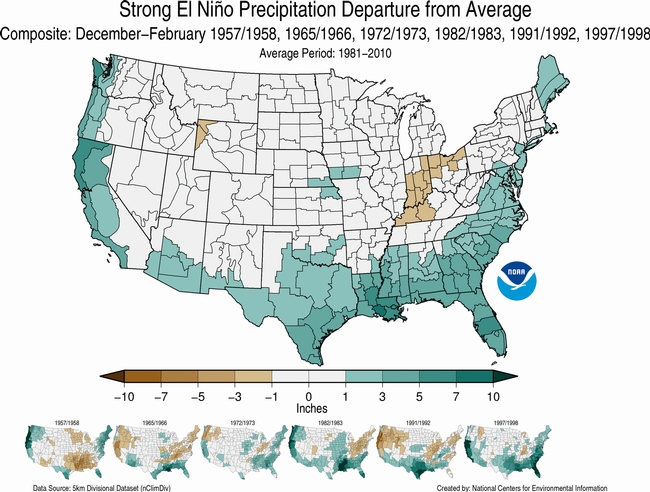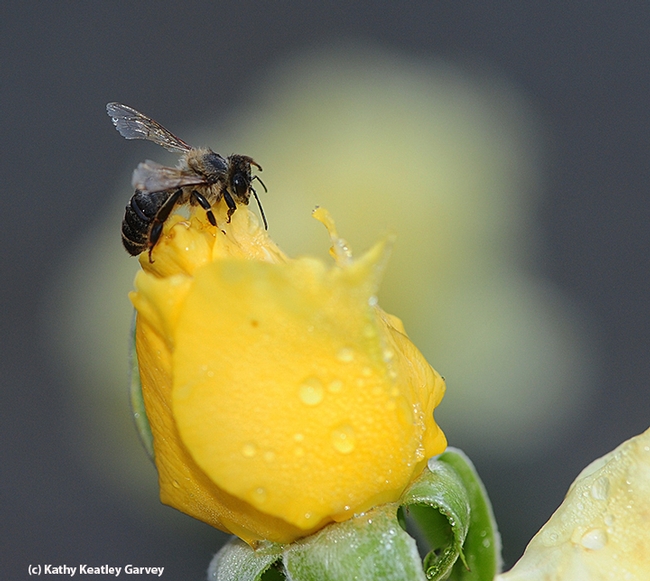
Posts Tagged: El Niño
El Niño isn't filling Monterey County lakes as quickly as other state reservoirs

In December, Lake Nacimiento was at 16 to 17 percent of capacity. It has now risen to 22 percent. Lake San Antonio, which dropped to 3 percent of capacity last summer, is still at 3 percent now. It is so low that engineers refer to it as a "dead pool" because gravity cannot pull water out of the reservoir when it is at that level.
The Monterey County lakes don't fill as quickly as other lakes - such as Shasta, Folsom and Oroville - because they are fed by relatively small watersheds. Nacimiento and San Antonio were built in the 1950s and '60s for flood control and to recharge aquifers. With dropping aquifer water levels, farmers have had problems with their wells, the story said.
“Some growers' wells pull in as much air as water, so that they need repairs or lose the wells entirely. I've seen well drillers around, which indicates re-drilling,” said Michael Cahn, a UC Agriculture and Natural Resources Cooperative Extension advisor in Monterey County. “This is a cost for agriculture.”
As they drill deeper, farmers also risk more seawater flooding in, contaminating the limited water supply. It was seawater intrusion that originally led to the construction of the Nacimiento and San Antonio dams.
Cahn was quoted at the end of the story with a positive message.
“The aquifers are currently at the lowest levels ever recorded, but they can go back up,” he said.
El Niño expected to drench California

Climate scientists refer to the anomaly as ENSO, for El Niño Southern Oscillation. The term describes the fluctuations in temperature between the ocean and atmosphere in the east-central Equatorial Pacific, just west of the Peruvian coast. The area is roughly between the International Date Line and 120 degrees west.
The ENSO cycle has three distinct phases: El Niño, La Niña and neutral. El Niño is defined when sea surface temperature is unusually warm for an extended period of time. La Niña is declared when equatorial Pacific is unusually cool for an extended period of time. Neutral phase is defined when the sea surface temperature is considered normal.
These large-scale changes in the surface water temperatures are linked to changes in the strength of the trade winds blowing from east to west across the region, which impacts weather patterns across the globe.
According to the NOAA Climate Prediction Center and International Research Institute for Climate and Society, a strong El Niño will continue through the Northern Hemisphere during the winter of 2015-16, followed by weakening and a transition to ENSO-neutral during the late spring or early summer.

Some of the expected outcomes are:
- Increased risk of flooding for California, since most of the precipitation is expected in the form of rainfall, rather than snow. Increasing streamflow in undammed rivers and quick filling of reservoirs that come with the potential for reservoir releases for flood control.
- Early bud breaking in many agricultural crops due to warmer than usual conditions. This can have significant yield impact on crops that rely on sufficient chill for proper development, such as citrus, apples, tree nuts and grapes.
- Increased aquifer recharge through so-called groundwater banking.
UC Agriculture and Natural Resources researchers will continue to monitor the El Niño Southern Oscillation and how it influences weather patterns in California. Future articles will provide detailed discussions on El Niño, with a focus on water resources impacts, effects on crops and potential for groundwater recharge.
An initiative to improve California water quality, quantity and security is part of the UC Division of Agriculture and Natural Resources Strategic Vision 2025.
Authors: Tapan Pathak, UC ANR Cooperative Extension specialist in climate adaptation in agriculture and Samuel Sandoval Solis, UC ANR Cooperative Extension specialist in water resources
Well-managed soils are ready to weather El Niño

“The soil-water interaction under various soil management practices will be quite clear if we do get the increased rainfall this winter that has been forecast,” Mitchell said. “Soil high in organic matter and covered by plant residue will allow increased water infiltration and storage, less water runoff and, on a large scale, increased groundwater recharge.”
Mitchell, a UC ANR Cooperative Extension specialist based at the UC Kearney Agricultural Research and Extension Center, has researched conservation agricultural practices for nearly 20 years. He is chair of UC ANR's Conservation Agriculture Systems Innovation Center (CASI), a collaborative organization involving researchers, farmers and industry partners who aim to increase the use of conservation practices in California.
Most farmers in the San Joaquin Valley till their land after harvesting row crops believing they have to create clean planting beds for seeding and establishment of subsequent crops. The practice, Mitchell said, is influenced mainly by tradition.
Research at the UC West Side Research and Extension Center that has been ongoing since 1999 has documented striking changes in plots after sustained cover cropping and no-till management. In addition to improved soil properties, the plots managed with conservation agriculture practices have comparable or in some cases higher yields, less soil water evaporation, lower dust emissions and, because of the higher soil organic matter, sequestered more carbon than adjacent plots managed using conventional practices.
In other parts of the world, generating and preserving plant residues are an indispensable part of farm management. Increasingly in California, farmers are implementing conservation tillage practices.
In addition to protecting soil from driving rain and wind in the winter, the plant residues provide important benefits in the summer. The plant residue on the surface shades the soil, providing a beneficial cooling effect, and soil with high organic content has higher moisture holding capacity.
“A number of studies from both irrigated and rain-fed regions around the United States where no-tillage is used have reported annual irrigation savings of as much as four to five inches,” Mitchell said.
Good soil management also promotes its biological diversity, noted Randal Southard, a CASI member and professor in the Department of Land, Air and Water Resources at UC Davis.
“Reducing soil disturbance, keeping the soil covered with plant residues and promoting high biological diversity provide soils with resilience – the ability of soils to accommodate changes in a wide array of environmental conditions,” Southard said. “Soil resilience or soil health is similar to how we think of human health, including overall well-being and the ability to resist diseases and other maladies.”
Soil is getting increasing attention in California and worldwide. The United Nations declared 2015 the International Year of Soils to raise awareness about a substance that is the very foundation of life on earth. The USDA's Natural Resources Conservation Service launched a Soil Health Campaign and the California Department of Food and Agriculture has created a Healthy Soils Initiative.
A network of soil health demonstration evaluations is now being created by CASI in California. Local teams are being organized in Sacramento, Mendocino, Stanislaus, Fresno and Kern counties involving Resource Conservation Districts, USDA Natural Resources Conservation Service and UC ANR Cooperative Extension researchers and local farmers. The farmers will set aside small comparison plots to evaluate practices that are believed to improve soil health and the researchers will have a role in monitoring and documenting changes.
“Each of these efforts points to the pivotal role healthy soils have in food security, agricultural sustainability and climate change resiliency,” Mitchell said.
Author: Jeannette Warnert
That Wet Stuff!
The rain that pounded Northern California on Oct. 18--complete with thunder and lightening--also drenched a few honey bees that waited out the storm. Have you ever seen a thoroughly drenched bee? This one got caught in the storm and relocated from an African basil to a yellow rose in Vacaville,...

Honey bee caught in the storm attempts to dry off. (Photo by Kathy Keatley Garvey)

Honey bee on top of its world--a yellow rose. (Photo by Kathy Keatley Garvey)
